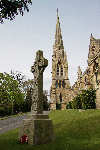Focus on St John’s Ranmoor, Sheffield,
BOB newsletter, June 2017
 Dedication – St
John the Evangelist
Dedication – St
John the EvangelistBells – A rite Royal 10 (plus Sanctus Bell)
Tenor – 16-1-5 in F
Frame – Cast iron on steel girders.
Tower Captain – Elaine Scott
Practice night – Tuesday:
6.30 ‘Tied’ Learners’ Practice
7.30 Open Practice
8.00 ‘Methodology’ focus – Odd & Even methods on alternate weeks
9.00 Debrief ‘bonding’ – The Ranmoor Inn
Randmoor - ‘the edge of the moor’ - was a picturesque piece of country on the outskirts of the growing town of Sheffield with a racecourse attracting the grinders and cutlers of Sheffield, the grandstand filled with the local patrons of sport, while through the woods and along the banks of Porter Brook and Oak Brook children played in spring and summer.
With the growing prosperity of the cutlery town, many mansions of the city’s wealthy leading industrialists sprang up in the district, and one John Newton Mappin, of Birchlands, conceived the idea of building in their midst the Church of St. John-the-Evangelist.
The noble church, with its lofty tower and graceful spire rising to a height of close upon 200ft (60m), the highest in Sheffield, was completed in 1879 by his munificence, and a peal of eight bells cast by James Barwell of Birmingham, was presented by William Smith Esq of Hallam Head – Fulwood & Hallmashire works. This handsome ring of eight, hyped as the best in the world! first rang out on Christmas Day 1880.
The parish was created in 1877 and the first church, by E M Gibbs, opened in 1879. Only the tower and spire survived as disastrous fire, emanating from a heating flue housed behind the organ, spread and left the building in ruin in 1887, the year of Queen Victoria’s Jubilee,
The tower door was in flames. A well-directed volume of water soon put all danger at an end; but one of the ringers, a man named Hinde who shortly afterwards ascended the tower steps and went into the belfry, found that both the tower and belfry were full of smoke. None of the woodwork, however, showed signs of heat, and the bells were uninjured.
The tower and spire housing the bells were incorporated into the new building design, also by Gibbs (of Flockton & Gibbs). An elegant phoenix arose from the ashes, was consecrated in 1888 having been inspired by the High Victorian ideal of creating a treasure house for God - that would have made John Ruskin’s heart sing - its prosperous parishioners were generous in their donations. Set imposingly on rising ground, Pevsner rates it the finest of Sheffield’s C19 Churches ‘opulent outside and inside’. The undamaged bells with a 15cwt tenor, continued in service, but were in need of rehanging and improvement of tone.
From Ringing World Vol 29, Iss 1204
Saturday 31st March 1934 - NEW RING OF TEN AT RANMOOR – A MEMORIAL TO THE LATE SAM THOMAS draws a congregation including 100 ringers of the district.
The inscriptions on the present bells best chronicles their own story:
9. The Church is the gift of John Newton Mappin Esq. Birchlands, Sheffield
7. This Peal and Church are dedicated to St. John the Evangelist. C.M.Gibbs Architect, Sheffield
10. This peal of 8 bells presented to Ran Moor Church by William Smith Esq. of Fulwood & Hallamshire Works Sheffield. James Barwell, Founder, Birmingham, 1878
The original peal of eight bells was recast in 1934 by subscriptions from the Parishioners. H.C.Foster. Vicar.
1&2. These bells added to the original peal of eight by the Sheffield and District Society of Change ringers in memory of Sam Thomas in 1934
8. This peal of bells hung and fittings by James Shaw & Son under superintendence of J.R.Cordingley of Bradford.
5. When we join our cheerful sound, Let love and loyalty abound.
At the service of dedication, the Bishop of Sheffield delivered a veiled stern warning, inferring that Sheffield’s assembled ringers may have been in need of discipline…
Receive these bells that have been solemnly set apart from profane and unhallowed uses as a sacred trust committed unto thee as the appointed Minster of Christ in this Church, and take care that they be ever and only used in God’s service and for His Glory.
Immediately after the service, the bells burst forth into their first changes, a well struck touch of Stedman Caters being rung by a specially picked band of ringers, all of whom bad been closely associated with the late Mr. Sam Thomas (1870-1924), one of the early founders of the Sheffield District Association of Change Ringers and leader of the belfry for many years. Hailing from Wath-on-Dearne, of an old ringing family, he learned to ring at the age of nine, joining the Parish Church (now the Cathedral) company in 1889. He rang his first peal with them, and was associated with the Ranmoor band from 1896 until his death.
He composed, rang and conducted the first peal of Original Major and was known throughout the country for his teaching ability, especially of young learners, as much as for his own excellence as a ringer and conductor of outstanding ability.
No further major work was done on the bells until the refurbishment of 1992 when the fittings, (bearings and pullies) were renovated by John Taylor & Co. of Loughborough, the local band supplying the labour.
And today? The Ranmoor Ringers mission? To engender a quality collaborative lifelong-learning agenda, in the vein of Sam Thomas, passing on traditions, promoting a safe and elegant style with an ear for accurate striking and aspiring to an enriched and rewarding methodology repertoire, and encouraging rooky conductors.
The ringers have two outings a year, and an annual Ringers Feast, to thank those who have contributed to the years ringing.
Tony Jones
So much more to read about Ranmoor Bells - http://www.ranmoorringers.org.uk [thats here!]
End of Article